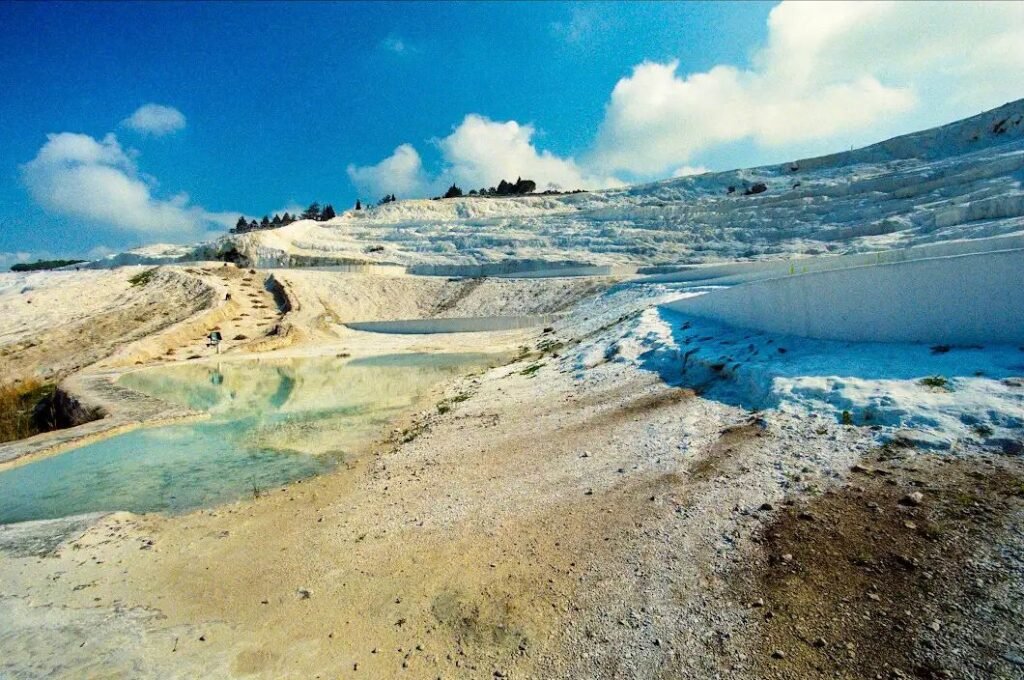Description
Pamukkale Travertines: Turkey's Stunning Natural Wonder
Nestled in the Denizli Province of southwestern Turkey, Pamukkale, which translates to "Cotton Castle" in Turkish, is a marvel of nature that leaves visitors awestruck. Famous for its surreal white terraces, formed by calcium-rich thermal waters, and its historical significance, Pamukkale is a UNESCO World Heritage site that attracts millions of tourists every year. This article delves into the geological wonders, historical treasures, and cultural significance of this extraordinary destination.
The Formation of the Travertines
The travertines of Pamukkale were created over thousands of years by mineral-rich hot springs. The water emerges from the ground at a temperature of around 35-100°C (95-212°F) and contains high concentrations of calcium carbonate. As the water flows down the slopes, it cools and deposits calcium carbonate, which eventually hardens into travertine. The result is a series of cascading white terraces filled with turquoise pools that resemble frozen waterfalls. The unique formation process gives the landscape its ethereal beauty and makes it one of the most photogenic locations in the world.
Hierapolis: The Ancient City Above the Travertines
Perched above the travertines is the ancient city of Hierapolis, another gem that enhances Pamukkale’s allure. Founded in the 2nd century BCE by the Attalid kings of Pergamon, Hierapolis became a prominent Greco-Roman spa city due to its proximity to the thermal springs. The ruins of Hierapolis include:
- Theater: A well-preserved Roman theater with a seating capacity of over 12,000. Its intricate carvings and impressive architecture showcase the grandeur of ancient Roman engineering.
- Necropolis: One of the largest ancient cemeteries in Turkey, with over 1,200 tombs that date back to the Hellenistic, Roman, and early Christian periods.
- Temple of Apollo: Dedicated to the god of light, music, and prophecy, this temple stands near the Plutonium, a cave that emits toxic gases, believed to be an entrance to the underworld in ancient times.
- Cleopatra’s Pool: A thermal pool filled with submerged columns and ruins, believed to have been a gift from Mark Antony to Cleopatra. Today, visitors can take a dip in its mineral-rich waters.
The combination of natural beauty and historical richness makes Pamukkale and Hierapolis a must-visit destination for history enthusiasts and nature lovers alike.
The Healing Powers of Pamukkale’s Thermal Waters
Since antiquity, Pamukkale’s thermal waters have been renowned for their healing properties. Ancient Romans and Byzantines flocked to Hierapolis to bathe in the springs, seeking relief from ailments such as rheumatism, cardiovascular diseases, and skin disorders. Even today, many believe in the therapeutic benefits of the waters, which are rich in minerals like calcium, magnesium, and bicarbonate. Visitors can walk barefoot on designated sections of the travertines and immerse themselves in the warm pools to experience their soothing effects.
Conservation and Tourism
Pamukkale’s popularity as a tourist destination has posed challenges for its conservation. In the past, unregulated tourism and the construction of hotels on the travertines caused significant damage. However, strict measures have since been implemented to protect this natural wonder. The hotels were demolished, and visitors are now required to follow specific rules, such as walking barefoot to prevent erosion and only accessing certain areas of the travertines.
In addition, a network of boardwalks and pathways allows visitors to admire the travertines without causing harm. These efforts have been instrumental in preserving Pamukkale’s pristine beauty for future generations.
Exploring the Surrounding Region
While the travertines and Hierapolis are the main attractions, the surrounding Denizli region offers plenty of other activities and sights to explore:
- Laodicea: An ancient city located near Pamukkale, known for its impressive ruins, including a large theater, a stadium, and several churches.
- Kaklik Cave: Often referred to as "Underground Pamukkale," this cave features travertine formations similar to those of Pamukkale but on a smaller scale.
- Denizli Textile Market: The region is famous for its high-quality textiles, particularly towels and bathrobes. Visitors can shop for these authentic Turkish products at local markets.
Best Time to Visit Pamukkale
The best time to visit Pamukkale is during spring (April to June) or autumn (September to November) when the weather is pleasant, and the crowds are smaller. Summers can be scorching, while winters may be too cold to enjoy the thermal pools fully. Regardless of the season, visiting early in the morning or late in the afternoon allows you to avoid the peak tourist rush and witness the travertines bathed in soft, golden light.
Tips for Visitors
To make the most of your visit to Pamukkale, consider the following tips:
- Wear Comfortable Clothing: Lightweight and breathable fabrics are ideal, especially if you plan to explore Hierapolis.
- Bring Swimwear: Don’t miss the opportunity to swim in Cleopatra’s Pool or relax in the thermal waters.
- Stay Hydrated: The warm climate and walking can be tiring, so carry water with you.
- Respect the Rules: Follow the guidelines to protect the travertines and ensure a sustainable experience.
- Extend Your Stay: Spending a night in the nearby town of Denizli allows you to explore the area at a leisurely pace and enjoy the tranquility of Pamukkale after day-trippers leave.
Conclusion
Pamukkale Travertines is a destination that combines natural splendor, historical intrigue, and cultural richness. Its dazzling white terraces, healing waters, and the ancient city of Hierapolis make it a unique gem in Turkey’s treasure trove of attractions. Whether you are a history buff, a nature enthusiast, or a traveler in search of unique experiences, Pamukkale promises to leave you with memories that will last a lifetime. So, pack your bags and embark on a journey to this enchanting Cotton Castle—a true wonder of the world.
Location
-
Pamukkale, 20190 Pamukkale/Denizli








